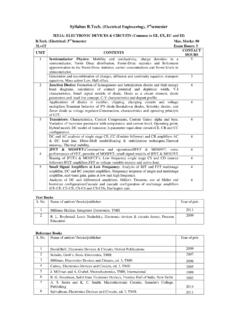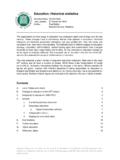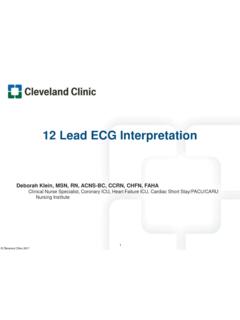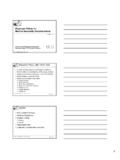Transcription of R.T.U., Kota Scheme and Syllabus B.Tech. (1
1 , Kota Scheme and Syllabus (1st and 2nd Semesters) effective from Session 2012 -13 2 | P a g e Scheme of Teaching & Examination for I year I Semester Effective from the Session: 2012 2013 (Common to all branches of Engineering) Sub Code Subject Number of Teaching Hours Per Duration of Theory Paper (Hours) Marks Allocation L T P Theory Term Test Sessional Prac. Exam Total 101 Communicative English 3 1 - 3 80 20 100 102 Engineering Mathematics-I 3 1 - 3 80 20 100 103 Engineering Physics-I 3 1 - 3 80 20 100 104 Engineering Chemistry 3 1 - 3 80 20 100 105 Basic Electrical & Electronics Engineering 3 - - 3 80 20 100 Total 15 04 - - 400 100 500 106 Engineering Physics Lab-I - - 2 - 45 30 75 107 Engineering Chemistry Lab 2 45 30 75 108 Electrical & Electronics Lab - - 2 - 60 40 100 109 Practical Geometry - - 3 60 40 100 110 Workshop Practice - - 2 60 40 100 111 Discipline & Extra curricular Activities - - - 50 - 50 Grand Total 15 04 11 - 400 100 320 180 1000 (Total 30 periods per week) , Kota Scheme and Syllabus (1st and 2nd Semesters) effective from Session 2012 -13 3 | P a g e Scheme of Teaching & Examination for I year II Semester Effective from the Session.
2 2012 2013 (Common to all branches of Engineering) Sub Code Subject Number of Teaching Hours Per Week Duration of theory Paper (Hours) Marks Allocation L T P Theory Term Test Sessional Prac. Exam Total 201 Communicatio n Techniques 2 - - 3 80 20 100 202 Engineering Mathematics-II 3 1 - 3 80 20 100 203 Engineering Physics-II 2 1 - 3 80 20 100 204 Chemistry & Environmental Engineering 3 1 - 3 80 20 100 205 Engineering Mechanics 3 1 - 3 80 20 100 206 Fundamentals of Computer Programming 3 - - 3 80 20 100 Total 16 04 - - 480 120 600 207 Engineering Physics Lab-II - - 2 - 30 20 50 208 Chemistry & Environmental Engineering Lab - - 2 - 30 20 50 209 Computer programming lab - - 2 45 30 75 210 Machine Drawing - - 3 - 60 40 100 211 Communication Technique Lab - - 2 - 45 30 75 212 Discipli ne & Extra Curricular Activities - - - - - 50 - 50 Grand Total 16 04 11 - 480 120 260 140 1000 (Total 31 periods per week) L = Lecture, T = Tutorial, P = Pr actical , Kota Scheme and Syllabus (1st and 2nd Semesters)
3 Effective from Session 2012 -13 4 | P a g e 101 COMMUNICATIVE ENGLISH Unit 1 Grammar 1. Tenses 2. Passive Voice 3. Indirect Speech 4. Conditional Sentences 5. Modal Verbs Unit 2 Composition 1. Dialogue Writing 2. Paragraph and Precis Writing 3. Report, its importance and Report Writing Unit 3 Short Stories 1. The Luncheon: Maugham 2. How Much Land Does a Man Need?: Leo Tolstoy 3. The Last Leaf: O. Henry Unit 4 Essays 1. On the Rule of the Road: A. G. Gardiner 2. The Gandhian Outlook: S. Radhakrishnan 3. Our Own Civilisation: Joad Unit 5 Poems 1. The Unknown Citizen: W. H. Auden 2. The Character of A Happy Life: Sir Henry Wotton 3. No Men are Foreign: James Kirkup 4. If : Rudyard Kipling Suggested Readings 1. Communication Skills for Engineers and Scientists, Sangeeta Sharma & Binod Mishra, PHI Learning Pvt. Ltd. 2. English for Engineers: Made Easy, Aeda Abidi & Ritu Chaudhary, Cengage Learning, (New Delhi) 3. A Practical Course for Developing Writing Skills in English, Gangal, PHI Learning Pvt.
4 Ltd., New Delhi. 4. Intermediate Grammar, Usage and Composition, Tickoo, A. E. Subramaniam & P. R. Subramaniam, Orient Longman (New Delhi) 5. The Written Word , Vandana R. Singh, Oxford University Press (New Delhi) , Kota Scheme and Syllabus (1st and 2nd Semesters) effective from Session 2012 -13 5 | P a g e 6. The Great Short Stories edited by Datta, Ram Narain Lal Publishers (Allahabad) 7. Professional Communication, Kavita Tyagi & Padma Misra,PHI Learning Pvt. Ltd., New Delhi. 8. Learn Correct English: Grammar, Usage and Composition by Shiv K. Kumar & Hemalatha Nagarajan, Pearson (New Delhi). 9. Current English Grammar and Usage with Composition by Sinha, Oxford University Press (New Delhi). 10. Grammar of the Modern English Language , by Sukhdev Singh & Balbir Singh, Foundation Books (New Delhi). 102 ENGINEERING MATHEMATICS-I Unit 1 Differential Calculus:Asymptotes(Cartesian Coordinates Only), Curvature(Cartesian Coordinates Only), Concavity, Convexity and Point of Inflexion (Cartesian Coordinates Only), Curve Tracing (Cartesian and Standard Polar Curves-Cardioids, Lemniscates of Bernoulli, Limacon, Equiangular Spiral).
5 Unit 2 Differential Calculus: Partial Differentiation, Euler s Theorem on Homogeneous Functions, Approximate Calculations, Maxima & Minima of Two and More Independent Variables, Lagrange s Method of Multipliers. Unit 3 Integral Calculus: Surface and Volumes of Solids of Revolution, Double Integral, Double Integral by changing into polar form , Areas & Volumes by Double Integration ,Change of Order of Integration, Beta Function and Gamma Function (Simple Properties). Unit 4 Differential Equations: Differential Equations of First Order and First Degree - Linear Form, Reducible to Linear form, Exact Form, Reducible to Exact Form, Linear Differential Equations of Higher Order with Constant Coefficients Only. Unit 5 Differential Equations: Second Order Ordinary Differential Equations with Variables Coefficients, Homogeneous and Exact Forms, Change of Dependent Variable, Change of Independent Variable, Method of Variation of Parameters.
6 Suggested Readings 1. Advanced Engineering Mathematics, Erwin Kreyszig, Wiley 9th Edition. 2. Calculus and Analytical Geometry, Thomas and Finney, Narosa Publishing House. New Delhi. 3. A Text Book of Differential Equations, and Chaturvedi, Students Friends & Co. Publisher, Agra. 4. Higher Engineering Mathematics, , Tata McGraw Hill. , Kota Scheme and Syllabus (1st and 2nd Semesters) effective from Session 2012 -13 6 | P a g e 5. Thomas Calculus, Maurice D. Weir, Joel Hass and others, Pearson, 11th Edition. 103 ENGINEERING PHYSICS-I Unit 1 Interference of light Michelson s Interferometer: Production of circular & straight line fringes, Determination of wavelength of light, Determination of wavelength separation of two nearby wavelengths. Newton s rings and measurement of wavelength of light. Optical technology: Elementary idea of anti-reflection coating and interference filters. Unit 2 Polarization of light Plane circular and elliptically polarized light on the basis of electric (light) vector, Malus law.
7 Double Refraction: Qualitative description of double refraction phase retardation plates, quarter and half wave plates, construction, working and use of these in production and detection of circularly and elliptically polarized light. Optical Activity: Optical activity and laws of optical rotation, Specific rotation and its measurement using half-shade and bi-quartz devices. Unit 3 Diffraction of light Single slit diffraction: Quantitative description of single slit, position of maxima / minima and width of central maximum, intensity variation. Diffraction Grating: Construction and theory, Formation of spectrum by plane transmission grating, Determination of wavelength of light using plane transmission grating. Resolving power: Geometrical & Spectral, Raleigh criterion, Resolving power of diffraction grating and telescope. Unit 4 Elements of Material Science Bonding in Solids: Covalent bonding and Metallic bonding.
8 Classification of Solids as Insulators, Semiconductors and Conductors. Semiconductors: Conductivity in Semiconductors, Determination of Energy gap of Semiconductor. X-Ray diffraction and Bragg s Law. Hall Effect: Theory, Hall Coefficient and applications. Unit 5 Special Theory of Relativity Postulates of special theory of relativity, Lorentz transformations, relativity of length, mass and time. Relativistic velocity addition and mass-energy relation, Relativistic Energy and momentum. Suggested Readings , Kota Scheme and Syllabus (1st and 2nd Semesters) effective from Session 2012 -13 7 | P a g e 1. Fundamental of Optics, Jenkins and White, Fourth Edition, McGraw Hill. 2. Optics, Ajoy Ghatak, Third Edition, Tata McGraw Hill. 3. Concept of Modern Physics, A. Baiser, Fifth Edition, McGraw Hill. 4. Modern Physics, J. Morrison, Edition 2011, Elsevier. 5. Elements of Material Science and Engineering, Van Vlack, Sixth Edition, Pearson.
9 104 ENGINEERING CHEMISTRY Unit 1 General Aspects of Fuel: Organic fuels, Origin, classification and general aspects of fossil fuels. Solid fuels, Coal, carbonization of coal, manufacturing of coke by Beehive oven and by product oven method. Liquid fuels, Composition of petroleum, advantages and refining of petroleum. Cracking, reforming, polymerization and isomerization of refinery products. Synthetic petrol, Bergius and Fischer Tropsch process. Knocking, octane number and anti-knocking agents. Gaseous fuels, Advantages, manufacturing, composition and calorific value of coal, gas and oil gas. Unit 2 Fuels Analyses: Ultimate and proximate analysis of coal, Determination of calorific value of solid and gaseous fuels by bomb and Junker s Calorimeter respectively. Calculations of calorific value based on Dulong s formula. Combustion, requirement of oxygen/ air in combustion process. Flue gas analysis by Orsat s apparatus and its significance.
10 Unit 3 Polymers: Different methods of classification, basic ideas of polymerization mechanisms. Elastomers: Natural rubber, vulcanization, Synthetic Rubbers viz. Buna-S, Buna-N, Butyl and neoprene rubbers. New Engineering Materials: Fullerenes: Introduction, properties, preparation and uses. Organic Electronic Materials (including conducting polymers- poly (p-phenylene), polythiophenes, Polyphenylene, vinylenes, polypyroles, polyaniline). Unit 4 Cement: Definition, Composition, basic constituents and their significance, Manufacturing of Portland cement by Rotary Kiln Technology, Chemistry of setting and hardening of cement and role of gypsum. Glass: Definition, Properties, Manufacturing of glass and importance of annealing in glass making, Types of silicate glasses and their commercial uses, Optical fiber grade glass. Unit 5 Refractory: Definition, classification, properties, Requisites of good refractory and manufacturing of refractory.








